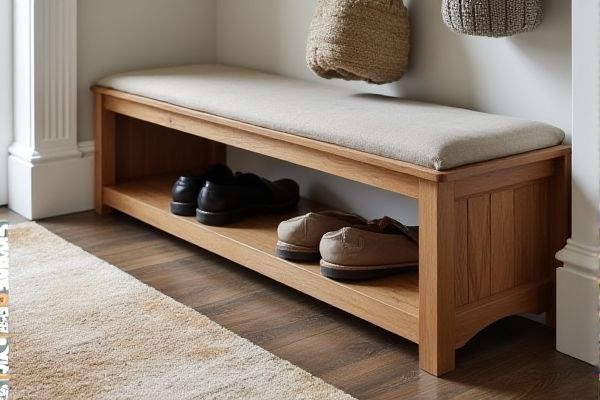
A mudroom shoe tray is designed with compartments or slots to organize multiple pairs of shoes neatly, while a boot tray typically features a larger, flat surface to accommodate taller footwear like boots and prevent dirt and water from spreading. To discover which option best suits your needs and keeps Your entryway tidy, read the rest of the article.
Table of Comparison
| Feature | Mudroom Shoe Tray | Boot Tray |
|---|---|---|
| Purpose | Designed to hold and organize shoes in entryways. | Specifically made to contain boots and larger footwear. |
| Size | Smaller, fits multiple shoes side-by-side. | Larger, accommodates tall boots and bulky footwear. |
| Material | Usually plastic, rubber, or metal with drainage features. | Durable rubber or heavy-duty plastic with raised edges. |
| Design | Flat or slightly raised with compartments for shoes. | Deep, contoured base to hold water, mud, and debris. |
| Placement | Indoor mudroom or entryway floors. | Entryways, garages, or outdoor covered areas. |
| Water & Dirt Control | Moderate protection; may drain water and dirt. | High containment; prevents mud and water spillage. |
| Common Brands | OXO, Umbra, Joseph Joseph | Drymate, Hubbell, Easy-Off |
Mudroom Shoe Tray vs Boot Tray: Key Differences
Mudroom shoe trays are typically designed with shallow grooves and smaller dimensions to accommodate everyday shoes, enhancing organization and preventing dirt from spreading indoors. Boot trays, on the other hand, feature deeper walls and larger surface areas to contain mud, water, and debris from taller, heavier footwear like boots. Selecting the right tray for your space ensures better protection for your floors and maintains cleanliness in your entryway.
Purpose and Functionality of Shoe Trays
Mudroom shoe trays are designed to organize and contain everyday footwear, preventing dirt and moisture from spreading inside your home. Boot trays, on the other hand, are larger and deeper to accommodate bulky, tall boots, providing extra space to catch mud, snow, and water. Both trays enhance the cleanliness and functionality of your entryway by keeping shoes and boots neatly contained and off the floor.
Boot Trays: Design and Practical Uses
Boot trays are specifically designed with deeper and larger dimensions to accommodate bulky footwear such as winter boots and rain boots, preventing dirt and water from spreading onto floors. They often feature raised edges and textured surfaces to contain mud, snow, and moisture effectively. Practical uses include protecting entryway floors, organizing wet or dirty footwear, and providing a designated space for drying boots without damaging household surfaces.
Material Comparison: Shoe Tray vs Boot Tray
Mudroom shoe trays are usually made from durable plastic or rubber, designed to hold multiple pairs of shoes and withstand moisture and dirt. Boot trays often feature heavier-duty materials such as thick rubber or PVC to accommodate larger, heavier boots and provide extra protection from mud and water. Choosing the right tray material ensures Your footwear stays organized and protected longer.
Size and Capacity: Which Fits Your Needs?
Mudroom shoe trays typically offer a compact size designed to hold multiple pairs of shoes in an organized manner, making them ideal for everyday footwear storage. Boot trays are generally larger and deeper, constructed to accommodate bulkier items like boots and wet or muddy shoes, providing ample capacity to contain dirt and moisture. Choosing between the two depends on your footwear types and available space, with shoe trays maximizing organization for smaller shoes and boot trays offering superior protection and capacity for larger, messier footwear.
Cleaning and Maintenance Tips
Mudroom shoe trays generally feature smaller compartments and shallow edges designed to catch mud and dirt, making them easy to clean with a quick wipe or rinse. Boot trays, with their larger and deeper surfaces, require occasional scrubbing to remove accumulated mud and water, ideal for protecting floors from heavy boots. Both types benefit from regular cleaning with mild soap and water to prevent odors and maintain durability.
Style and Aesthetic Considerations
Mudroom shoe trays typically feature low-profile designs with sleek contours that complement modern home interiors, making them ideal for organizing everyday footwear without drawing excessive attention. Boot trays are often larger with raised edges and rugged textures, designed to accommodate bulkier boots while adding a rustic or utilitarian aesthetic to entryways. Choosing between the two depends on balancing the desired style, whether favoring minimalist elegance or durable practicality in mudroom decor.
Durability and Longevity
Mudroom shoe trays are typically crafted from sturdy plastic or rubber, designed for everyday use and moderate durability, while boot trays often feature reinforced materials like heavy-duty rubber or metal for enhanced strength and longer lifespan. The durability of a boot tray makes it ideal for protecting your floors from mud and water during harsher weather, extending the tray's longevity compared to standard shoe trays. Choosing a boot tray for your mudroom ensures you invest in a product that withstands heavy wear, safeguarding your entryway from dirt and moisture over time.
Best Placement Ideas for Trays in Mudrooms
Placing a mudroom shoe tray near the entry door allows easy removal and storage of dirty footwear, keeping your floors clean and organized. Boot trays are best positioned under coat racks or benches to catch mud and moisture from taller boots, protecting surfaces and simplifying cleanup. For optimal use, consider trays with raised edges and non-slip bases in high-traffic areas where wet shoes and boots are most likely to be removed.
How to Choose the Right Tray for Your Home
Choosing the right tray for your home depends on the type of footwear and available space; a mudroom shoe tray is ideal for daily shoes with individual slots or compartments to keep pairs organized and dry. Boot trays, designed with deeper edges and larger flat surfaces, are better suited for heavy, wet, or muddy boots, preventing dirt and water from spreading on floors. Consider the tray's material, size, and ease of cleaning to ensure it fits your home's mudroom layout and usage needs effectively.
 homyna.com
homyna.com